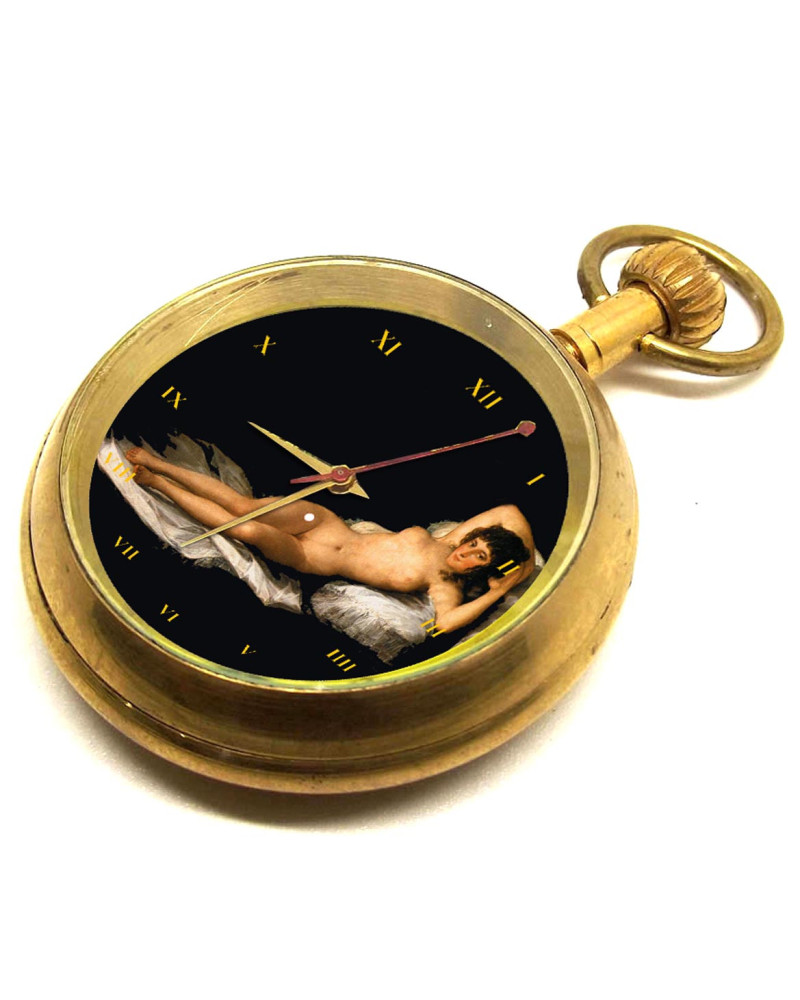




⦿ 50 mm large size heavy brass case with see-through mineral glass back.
⦿ Original 1960s 17-jewel mechanical hand-winding movement.
⦿ Unique collectible limited edition handmade watches with great investment potential.
Francisco Goya’s The Naked Maja (La Maja Desnuda, c. 1797–1800) is one of the most provocative and controversial nude paintings in art history. Created at a time when explicit nudity was largely reserved for mythological or religious contexts, Goya’s portrait of a fully nude, reclining woman with an unabashed gaze defied artistic conventions and sparked scandal, intrigue, and fascination.
The painting’s boldness not only shaped 19th-century eroticism in art but also influenced modern representations of the nude, paving the way for later artists to explore sensuality, realism, and female agency in erotic art. This article explores the historical reception of The Naked Maja, its impact on censorship and artistic freedom, and its enduring influence on erotic art and photography.
Francisco Goya (1746–1828) was a Spanish painter whose works spanned Romanticism, portraiture, and political satire. While he is widely known for his court paintings and later dark, nightmarish imagery (The Black Paintings), he was also a pioneer of erotic realism.
In the 18th century, most nude artworks depicted figures from mythology or biblical stories (e.g., Titian’s Venus of Urbino or Velázquez’s Rokeby Venus).
The Naked Maja shattered this tradition by depicting a real woman, without allegory or divine justification.
The subject’s direct gaze, confident pose, and lack of accessories emphasized her sexual presence, making the painting boldly modern for its time.
It is widely believed that The Naked Maja was commissioned by Manuel de Godoy, the Spanish Prime Minister and a well-known collector of erotic art.
The identity of the model remains uncertain—some speculate she was Godoy’s mistress Pepita Tudó, while others believe she was the Duchess of Alba, a close friend of Goya’s.
In 1815, the Spanish Inquisition seized the painting, considering it obscene and immoral.
Unlike traditional nudes, The Naked Maja lacked the mythological or religious excuse that had previously protected artists from accusations of indecency.
Goya was summoned to the Inquisition to explain his work, though he avoided severe punishment.
In response to the controversy, Goya created The Clothed Maja (La Maja Vestida), a nearly identical painting, but with the subject fully dressed.
Some speculate that the pairing of the two works was intended as a statement on repression, censorship, and the shifting boundaries of eroticism in art.
Despite its early censorship, The Naked Maja became a groundbreaking influence on the evolution of erotic art, inspiring painters, photographers, and filmmakers to explore sensuality in more daring ways.
Édouard Manet’s Olympia (1863) directly echoes The Naked Maja in its reclining nude, direct gaze, and scandalous reception.
Manet, like Goya, depicted a real woman, not a goddess, emphasizing the humanity and agency of the female nude.
With the invention of early photography (daguerreotypes and carte de visite prints), photographers looked to Goya’s bold realism as inspiration.
1920s French erotic postcards, known for their playful and sensual compositions, drew on Goya’s Maja for their confident, unashamed representations of the nude.
Salvador Dalí’s reinterpretations of The Naked Maja infused surrealism into its sensuality, showing how Goya’s work transcended classical realism.
Man Ray’s erotic photography, with its dreamlike lighting and confident female subjects, mirrors the unapologetic sensuality of Goya’s nude.
While originally painted for a male aristocrat’s private collection, The Naked Maja has been reclaimed in feminist and contemporary discussions about the portrayal of female sensuality.
Historically, the painting was viewed as scandalous and indecent, but today, it is often seen as an assertion of female sexuality.
Unlike many earlier nudes, the Maja’s confident gaze engages the viewer directly, rather than being passively objectified.
Female artists such as Jenny Saville and Cindy Sherman have explored the theme of nude self-representation, questioning how women’s bodies are viewed in art.
The shift from male-gaze eroticism to female-authored sensuality owes much to Goya’s daring portrayal of a nude woman as a subject, rather than an object.
The painting has been referenced in films, literature, and advertising, often as a symbol of forbidden beauty and the defiance of social norms.
In 1958, Ava Gardner played a fictionalized version of the Maja in The Naked Maja, a Hollywood retelling of Goya’s artistic rebellion.
Francisco Goya’s The Naked Maja remains one of the most influential erotic paintings in history, challenging censorship, artistic norms, and the depiction of female sensuality.
Its scandalous reception by the Spanish Inquisition underscored society’s discomfort with realistic, unapologetic nudity, yet it became a template for generations of artists exploring erotic themes.
From Manet’s Olympia to modern feminist reimaginings, The Naked Maja continues to shape the dialogue around desire, agency, and the artistic nude, proving that erotic art is not just about sensuality—it is about power, defiance, and the freedom of expression.